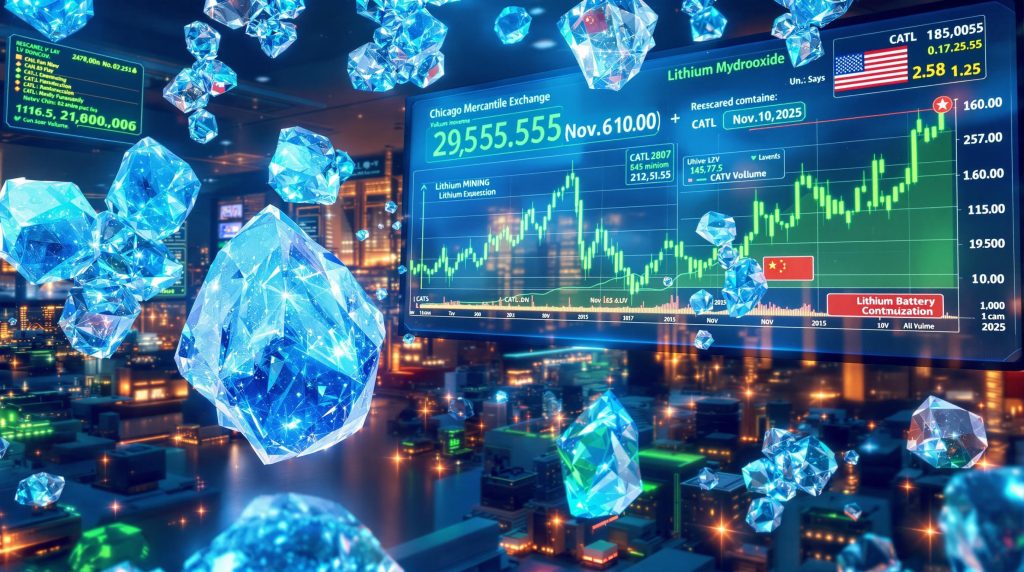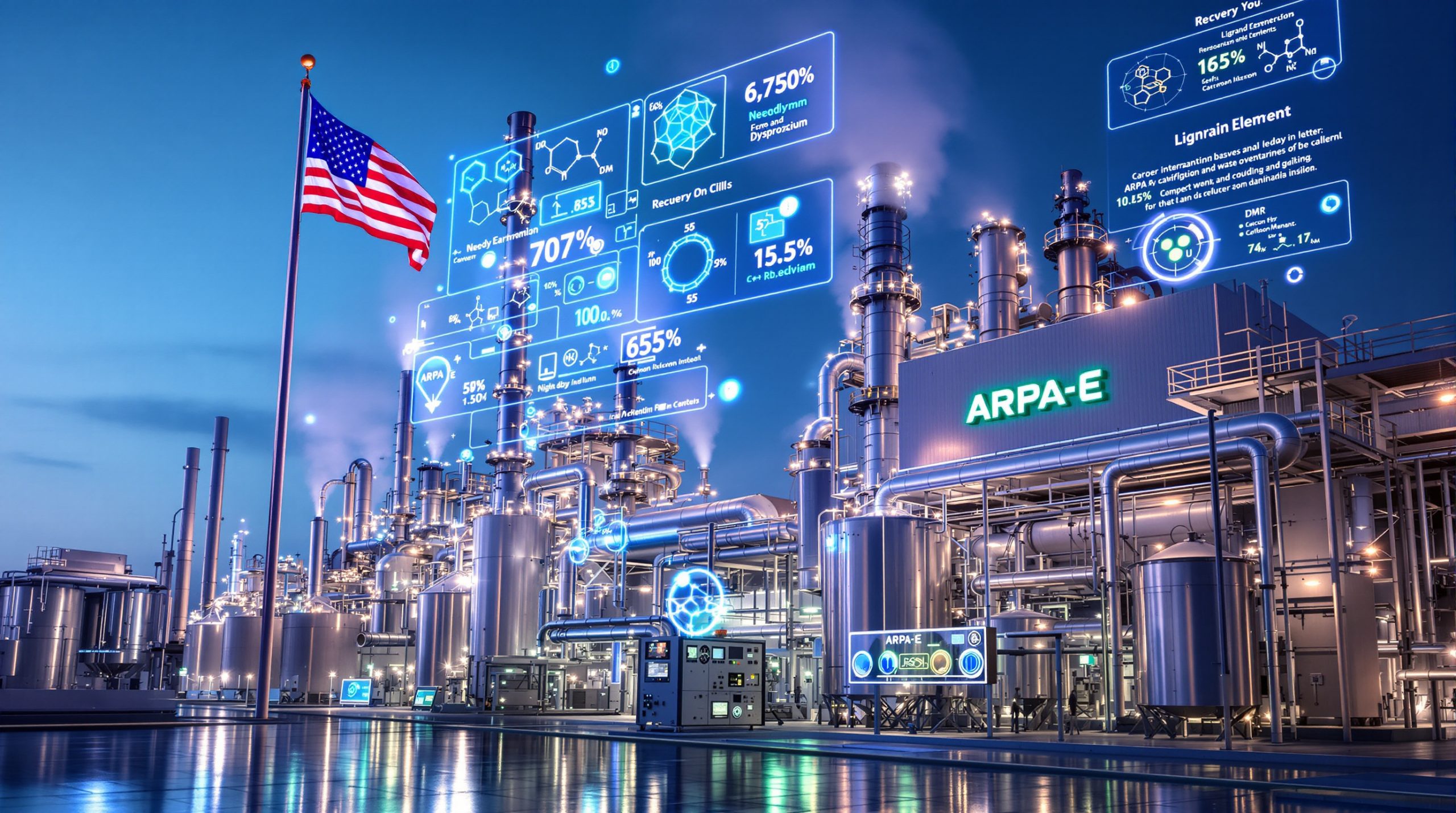CME Lithium Hydroxide Futures Market Shows Record Growth in 2025
The lithium futures market has reached new heights in 2025, with the Chicago Mercantile Exchange (CME) lithium hydroxide contract breaking multiple trading records. July 2025 marked a watershed moment for the market, highlighting increased sophistication in battery materials trading and setting new benchmarks for market participation. This expansion reflects growing confidence in standardized financial instruments for lithium trading as the energy transition accelerates.
Record-Breaking Trading Volumes for CME Lithium Hydroxide Futures
July 2025: A Month of Unprecedented Activity
July 2025 established an all-time high for monthly trading volume, with 17,013 tonnes of lithium hydroxide changing hands through CME futures contracts. This impressive figure surpassed the previous record of 15,837 tonnes set in February 2025, demonstrating the market's continued expansion and increasing liquidity.
Daily trading volumes have also hit remarkable levels. The second-highest daily trading volume was recorded on August 8, 2025, with 1,910 lots traded. This approaches the all-time daily trading record of 2,161 lots established on February 11, 2025. These significant milestones underscore the growing importance of lithium futures as a price discovery and risk management tool.
Historical Growth Trajectory
Since its launch in 2021, the CME lithium hydroxide futures contract has experienced a transformative evolution. While initial adoption was gradual, trading activity began accelerating notably from 2023 onward, coinciding with increasing volatility in physical lithium markets.
The consistent growth in open interest positions—contracts that remain active rather than being closed out—indicates stronger commitment from market participants to maintain longer-term positions. This metric is particularly important as it represents genuine hedging and investment activities rather than short-term speculative trading.
The year 2025 has demonstrated particularly strong momentum, with month-over-month increases in trading volumes throughout most of the year, suggesting the market has reached a critical mass of participants necessary for sustainable growth.
Why CME Lithium Hydroxide Futures Are Gaining Traction
Market Fundamentals Shifting
"We are seeing increased participation in ex-China lithium futures markets, CME and SGX. This occurs amid signs that fundamentals may be shifting, as well as new participants entering the market," noted Przemek Koralewski, Global Head of Market Development at Fastmarkets.
The expansion beyond Chinese trading hubs represents a significant evolution for the global lithium market. New entrants are diversifying the trading ecosystem, bringing different perspectives and trading strategies that enhance market depth and liquidity.
Koralewski further observed that "The CME has also experienced the highest share of screen-based trading in total traded volumes. This could also attract new entrants and further expand the market." Screen-based trading—executed through electronic platforms rather than by phone or in person—typically indicates broader market participation and more transparent price discovery.
Pricing Transparency and Risk Management
The CME lithium hydroxide futures contract settles based on Fastmarkets' assessment for battery-grade lithium hydroxide CIF China, Japan, and Korea. This settlement mechanism provides critical price discovery for global lithium markets, offering a benchmark that can be used across supply chains.
For producers, these futures contracts enable more sophisticated hedging strategies that can protect against price declines while securing future revenue streams. Battery manufacturers and EV producers, conversely, can lock in supply costs, making financial planning more predictable despite volatile commodity prices.
The contracts have also attracted institutional investors seeking exposure to battery materials without the complexities of physical trading. As environmental, social, and governance (ESG) investing grows, lithium futures offer a liquid instrument for gaining exposure to the energy transition theme.
How Recent Supply Disruptions Have Impacted Futures Pricing
CATL's Mining Suspension and Market Response
A significant supply disruption occurred when Chinese battery producer CATL suspended lithium mining operations at its Jianxiawo lepidolite mine in Yichun, Jiangxi province on August 9, 2025. The operational halt was triggered by the expiration of the site's mining permit, creating immediate uncertainty in lithium supply chains.
Market participants have suggested this disruption could last as long as three months, although a source at CATL confirmed the mining suspension without specifying its expected duration. The impact was quickly reflected across lithium markets globally, with futures contracts showing particular sensitivity to the news.
The supply uncertainty surrounding one of China's significant domestic lithium sources demonstrates how regional regulatory issues can cascade through global markets, highlighting the interconnected nature of battery materials supply chains.
Contango Structure Development
Following the CATL mining suspension announcement, CME lithium hydroxide futures contracts developed a more pronounced contango structure—a market condition where future delivery prices are higher than near-term prices.
The August 2025 settlement rose $0.15 per kg to $8.20 per kg on August 11, while the September 2025 contract actually fell $0.15 per kg to $8.75 per kg. However, forward months showed much stronger reactions: the October 2025 contract jumped $0.68 per kg to $10.27 per kg, and the November 2025 contract surged $1.03 per kg to $10.65 per kg.
This sharper contango structure extending through November 2025 reflects market expectations that the supply disruption could persist through the fourth quarter, potentially creating tighter market conditions as battery manufacturers compete for available material.
Global Lithium Futures Exchanges Comparison
CME vs. Guangzhou Futures Exchange (GFEX)
While the CME lithium hydroxide futures showed significant price movements following the CATL news, China's Guangzhou Futures Exchange (GFEX) lithium carbonate futures also demonstrated sensitivity to the supply disruption, with gains visible across its forward curve.
An interesting divergence emerged between the two exchanges' forward curves. While CME's contango extended prominently through November as of August 11, the GFEX contango only extended to October as of August 12, 2025. Market participants have suggested this difference may reflect more speculative sentiment on the GFEX, with traders potentially expecting a faster resolution to the supply concerns.
Price Settlements Across Exchanges
GFEX lithium carbonate futures contracts settled at the following prices on August 12, 2025:
- August contract: 82,100 yuan ($11,428) per tonne
- September contract: 85,760 yuan per tonne
- October contract: 85,800 yuan per tonne
- November contract: 85,620 yuan per tonne
- December contract: 84,900 yuan per tonne
The price structure shows a peak in October before starting to decline, suggesting market expectations of supply recovery by year-end. This contrasts with the CME curve, which continued rising through November, highlighting regional differences in market sentiment and information flow.
Spot Lithium Prices Movement
Battery-Grade Lithium Price Movements
The physical spot markets for battery-grade lithium materials have also responded to the CATL mining suspension. Lithium hydroxide monohydrate (battery grade, CIF China, Japan & Korea) was assessed at $7.80-8.70 per kg on August 12, 2025, widening upward from the previous assessment of $7.80-8.30 per kg.
Similarly, lithium carbonate (battery grade, CIF China, Japan & Korea) was assessed at $9.00-9.80 per kg on August 12, narrowing upward from the previous day's range of $8.80-9.80 per kg.
The upward movement in both battery-grade lithium refinery and hydroxide prices CIF CJK demonstrates how supply disruptions immediately translate to higher price expectations in physical markets. The narrowing range for carbonate versus the widening range for hydroxide may indicate different market dynamics and liquidity between the two materials.
Price Assessment Methodology
Fastmarkets' assessments serve as the settlement basis for multiple futures contracts across global exchanges. These assessments consider battery-grade material specifications to ensure relevance to the high-growth electric vehicle and energy storage sectors.
The assessments specifically reflect CIF (Cost, Insurance, Freight) terms for key Asian markets—China, Japan, and Korea—which represent the primary demand centers for battery-grade lithium materials. Regular methodology reviews ensure these price benchmarks maintain market relevance as trading patterns evolve.
Global Exchanges Offering Lithium Futures Contracts
Major Exchanges and Contract Specifications
The growth in lithium futures trading has attracted participation from multiple major global exchanges:
- Chicago Mercantile Exchange (CME)
- Singapore Exchange (SGX)
- Intercontinental Exchange (ICE)
- London Metal Exchange (LME)
- Guangzhou Futures Exchange (GFEX)
Each exchange has developed contract specifications designed to serve different market segments. The CME, SGX, ICE, and LME contracts primarily target international traders and risk managers, while GFEX serves the domestic Chinese market with contracts denominated in yuan.
The proliferation of lithium futures across multiple exchanges demonstrates the material's growing importance as a strategic commodity for the energy transition. This multi-exchange landscape also provides traders with arbitrage opportunities and the ability to access different regional price dynamics.
Settlement Mechanisms
Most international contracts settle against Fastmarkets' price assessments, providing standardization across exchanges and enhancing price transparency. The GFEX, however, uses China-specific pricing mechanisms that reflect domestic market dynamics.
Contract specifications vary by exchange to accommodate different market segments and trading preferences. Some contracts focus specifically on battery-grade material, while others may incorporate technical-grade lithium products. Settlement periods typically align with physical delivery timeframes to ensure relevance to commercial trading patterns.
What Increased Futures Trading Means for the Lithium Market
Market Maturation Indicators
The growing futures volumes suggest increased market sophistication and acceptance of standardized financial instruments for lithium trading. The shift toward higher screen-based trading percentages indicates broader market participation beyond traditional physical traders.
Expanding open interest demonstrates that market participants are taking longer-term positions rather than simply day trading, suggesting genuine hedging and investment activities are driving volume growth. This contributes to more efficient price discovery and sends stronger signals about future market expectations.
As liquidity improves, bid-ask spreads typically narrow, reducing transaction costs and making the market more attractive to new participants. The increasing correlation between futures prices and physical market movements also suggests the financial markets are becoming more effective at price discovery.
Implications for Market Participants
Lithium producers gain additional hedging tools for price risk management, allowing them to secure future revenue streams and make more confident capital investment decisions. This is particularly valuable in an industry requiring significant upfront capital for mine development.
Consumers of lithium materials—primarily battery manufacturers and automotive companies—can lock in future supply costs, providing certainty for financial planning and potentially enabling more competitive pricing strategies for end products.
Traders benefit from increased liquidity and arbitrage opportunities across different exchanges and contract months. The growing market depth reduces slippage and execution risks, allowing for larger positions without significant market impact.
Institutional investors gain access to battery materials exposure through standardized instruments without the complexities of physical commodity handling. This broadens the investor base and potentially increases the capital available to the lithium industry.
How Regulatory Changes Might Impact Lithium Trading
Position Limits and Market Controls
As CME lithium hydroxide futures trading volume continues to grow, exchanges and regulators are implementing market controls to prevent excessive speculation and volatility. For example, the GFEX has reportedly imposed 3,000-lot daily position limits for non-futures firms to maintain orderly markets.
Such regulatory measures aim to address price volatility while maintaining sufficient liquidity for genuine hedging activities. Exchange rules continue to evolve to accommodate growing trading volumes while protecting market integrity.
The lithium market may see additional oversight as its strategic importance grows, particularly given its critical role in energy transition technologies and national security considerations for many countries.
International Regulatory Considerations
Cross-border trading requires navigating multiple regulatory frameworks, creating complexity for global market participants. Different jurisdictions may impose varying requirements for margin, position reporting, and market access.
Disclaimer: Regulatory environments for commodity futures trading vary significantly by jurisdiction and change frequently. Market participants should consult qualified legal advisors before engaging in cross-border lithium futures trading.
Harmonization efforts may emerge as the market continues to develop, potentially simplifying compliance requirements for international traders. Transparency requirements are likely to increase as regulators seek more visibility into these strategically important markets.
Environmental and sustainability regulations may eventually impact physical delivery specifications, particularly as ESG considerations become more prominent in commodity markets. Future contracts might incorporate sustainability criteria or carbon footprint considerations.
FAQ About CME Lithium Hydroxide Futures
What factors are driving the record trading volumes in lithium futures?
The surge in trading volumes can be attributed to several factors:
- Shifting market fundamentals creating price volatility
- Supply disruptions like CATL's mining suspension
- Increased participation from new market entrants
- Growing recognition of futures contracts as effective risk management tools
- Higher percentage of screen-based trading attracting institutional participants
- Greater acceptance of standardized price benchmarks
How do lithium futures contracts help market participants?
Lithium futures provide multiple benefits across the supply chain:
- For producers: Price hedging capabilities to secure future revenue and support investment decisions
- For consumers: Ability to lock in supply costs and manage budget certainty
- For traders: Efficient means of market participation without physical handling
- For investors: Exposure to battery materials markets through standardized instruments
- For all participants: Price transparency and discovery through liquid markets
What's the relationship between spot prices and futures contracts?
Futures contracts for lithium hydroxide settle based on spot price assessments from Fastmarkets. The relationship between current spot prices and futures contracts forms the futures curve, which can be in contango (future prices higher than spot) or backwardation (future prices lower than spot).
The current contango structure extending through November 2025 reflects market expectations about future supply-demand balances, with traders anticipating tighter supply conditions in the coming months due to disruptions like the CATL mining suspension.
How has the suspension of CATL's lithium mining operations affected the market?
The suspension has triggered immediate price reactions across both futures and spot markets:
- Futures contracts showing a sharper contango structure extending through November 2025
- Physical spot prices for both lithium hydroxide and carbonate moving higher
- Greater price volatility across multiple exchanges
- Divergent expectations between Chinese and international markets about the duration of impact
These market reactions reflect concerns about potential supply disruptions lasting up to three months, although official confirmation of the duration remains unavailable.
Which exchanges offer lithium futures trading opportunities?
Multiple global exchanges now offer lithium futures contracts:
- Chicago Mercantile Exchange (CME) – lithium hydroxide futures
- Singapore Exchange (SGX) – lithium contracts
- Intercontinental Exchange (ICE) – lithium derivatives
- London Metal Exchange (LME) – lithium contracts
- China's Guangzhou Futures Exchange (GFEX) – lithium carbonate futures
Each exchange offers different contract specifications and settlement mechanisms, providing market participants with multiple venues for price discovery and risk management.
Outlook for Lithium Futures Markets
The continued expansion of lithium futures trading volumes suggests growing market acceptance of these financial instruments. As electric vehicle adoption accelerates globally, the strategic importance of lithium price risk management will likely increase for both producers and consumers.
Market participants should monitor both physical supply dynamics and lithium market challenges that could impact futures trading. The interplay between Chinese domestic markets and international exchanges will remain a critical factor in price formation and trading opportunities.
As the market matures, we may see the development of more sophisticated derivatives, potentially including options on lithium futures that would provide additional flexibility for risk management strategies. Furthermore, Argentina lithium insights and Australia lithium innovations continue to influence market dynamics, particularly as new extraction technologies like geothermal lithium extraction show promise for diversifying global supply sources.
Disclaimer: This article contains forward-looking statements about commodity markets. Future conditions may differ materially from current expectations. Readers should conduct their own research before making investment or hedging decisions based on market commentary.
Want to Stay Ahead of the Next Major Mineral Discovery?
Discovery Alert's proprietary Discovery IQ model delivers real-time notifications on significant ASX mineral discoveries, turning complex data into actionable investment insights. Discover why historic mineral finds can generate substantial returns by exploring our dedicated discoveries page and begin your 30-day free trial today to position yourself ahead of the market.




